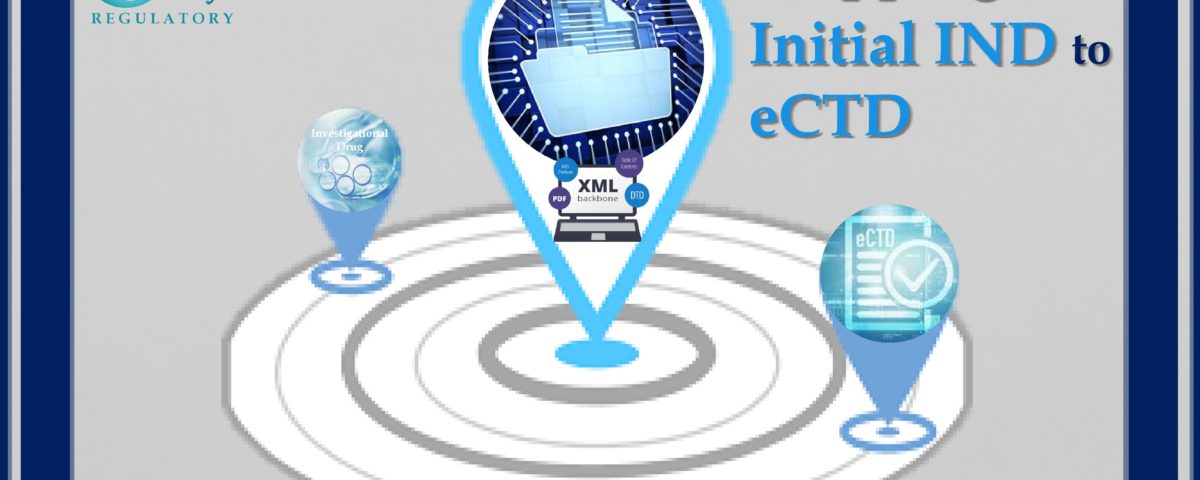Mapping an Initial IND Application to eCTD

Posted June 30, 2020 | By Pallab Roy
Introduction
An Investigational New Drug (IND) is a potential therapy a sponsor wants to test in human clinical trials. In the US, such testing must be covered by an IND Application. Essentially, an IND is a claim of exemption from certain FD&C Act legal requirements, allowing drug shipment in interstate commerce for the purpose of conducting clinical trials in the US.
Content of an Initial IND Application
The minimum information required to file an initial IND is preclinical animal pharmacology and toxicity data, information regarding the manufactured product’s quality and a clinical protocol with investigator information. However, the totality of information depends on such factors as the drug’s novelty, the extent to which it has been studied previously, its known or suspected risks and the drug’s developmental phase. For example, any additional information on previous human experience with the drug not conducted under an IND should be included in an initial IND.
Regulations pertaining to INDs can be found in 21 CFR 312. The IND utilizes Form FDA 1571, which lists the aspects and applicable CFR section. INDs from commercial sponsors must be submitted electronically.
eCTD Mapping
The first step in assembling IND documents is to obtain an IND number from FDA. The IND in electronic format is assembled according to the Common Technical Document (CTD) defined by ICH in 5 modular sections, as outlined below:
| IND Section [CFR Citation/ Source] | eCTD Module |
| Cover sheet (Form FDA-1571) [21 CFR §312.23(a)(1)] | 1.2 Cover letter; 1.1.1 Application form: FDA form 1571 |
| Table of Contents [21 CFR §312.23(a)(2)] | Not applicable – Replaced by XML backbone |
| Introductory Statement and General Investigational Plan [21 CFR §312.23(a)(3)] | 2.2 Introduction to summary; 1.20 General Investigational Plan |
| Investigator’s Brochure [21 CFR §312.23(a)(5)] | 1.14.4.1 Investigational Brochure |
| Study Protocol [21 CFR §312.23(a)(6)] | 5.3 under specific study |
| Investigator, Facilities and Institutional Review Board data [21 CFR §312.23(a)(6)(iii)(b)] | 5.3 under specific study |
| Chemistry, Manufacturing, and Control Information [21 CFR §312.23(a)(7)] | 2.3 Quality Overall Summary; Module 3 Quality – use appropriate submodule based on content supplied |
| Labeling [21 CFR §312.23(a)(7)(iv)(d)] | 1.14.4.2 Investigational Drug Label |
| Environmental assessment or claim for exclusion [21 CFR §312.23(a)(7)(iv)(e)] | 1.12.14 Environmental analysis |
| Pharmacology and Toxicology Information [21 CFR §312.23(a)(8)] | 2.4 Nonclinical Overview; 2.6 Nonclinical written and tabulated summaries [use appropriate sections]; 4.2 Study Reports [use appropriate sections] |
| Previous Human Experience [21 CFR §312.23(a)(9)] | 2.5 Clinical Overview; 2.7 Clinical Summary [use appropriate sections]; 5.3 Clinical Study Reports and related information [use appropriate sections] |
| Biosimilar User Fee Cover Sheet [BsUFA] | Form FDA 3792 |
| Clinical Trials Certification of Compliance [FDAAA] | 1.2.1 Certification of compliance: Form FDA 3674 |
| Other Administrative Information (if applicable) | |
| Written statement of authorization for references (copy of LOA received from DMF holders) [21 CFR §312.23(b)] | 1.4.2 Statement of Right of Reference |
| Pre-IND Meeting Minutes [21 CFR §312.47 PDUFA Agreements] | 1.6.3 Correspondence regarding meetings |
| Comment and advice on an IND [21 CFR §312.41] | 1.12.4 Request for comments and advice |
Documents are published in PDF format according to prescribed standards and assembled on an extensible markup language (XML) backbone using specialized software. The initial IND application is assigned a serial number starting with 0000. All electronic IND files are then submitted through FDA’s electronic submissions gateway (ESG).

